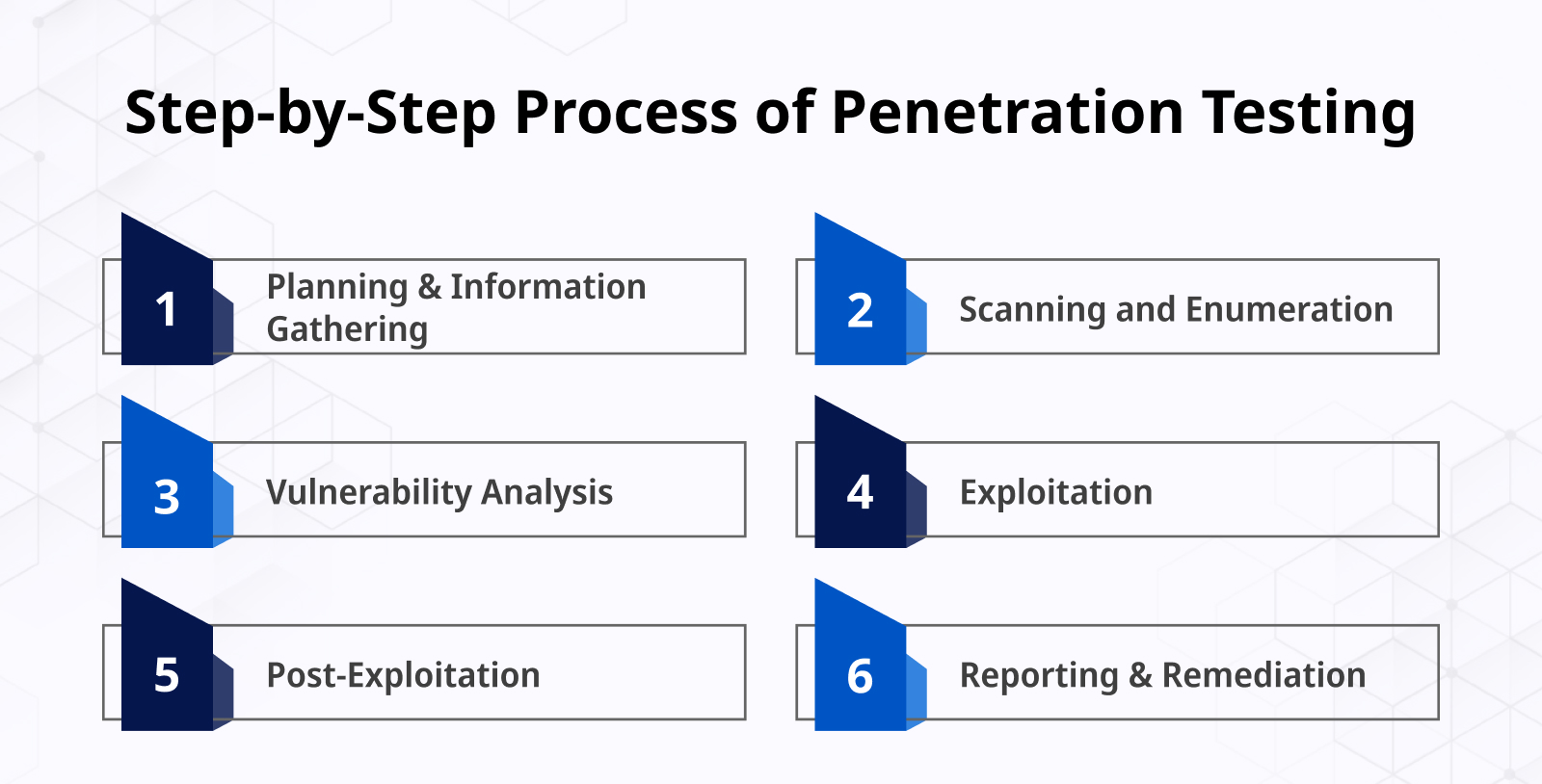However, they are also prime targets for cyber threats. To safeguard your business from these risks, you must proactively identify vulnerabilities.
It is where web application penetration testing, often referred to as ethical hacking, comes into play. It’s a critical tool in ensuring the security and integrity of your web applications.
By mimicking the tactics of real-world attackers, penetration testing exposes potential weaknesses before malicious hackers can exploit them.
This comprehensive guide will explore web application risks and demonstrate how penetration testing unveils these threats.
Table of Contents
The Importance of Web Application Security
Web app security is a fundamental pillar in today’s digital landscape, and its significance cannot be overstated.
In an era where businesses and individuals conduct an increasing amount of their activities online, the security of web applications plays a pivotal role in safeguarding sensitive information and ensuring user trust.
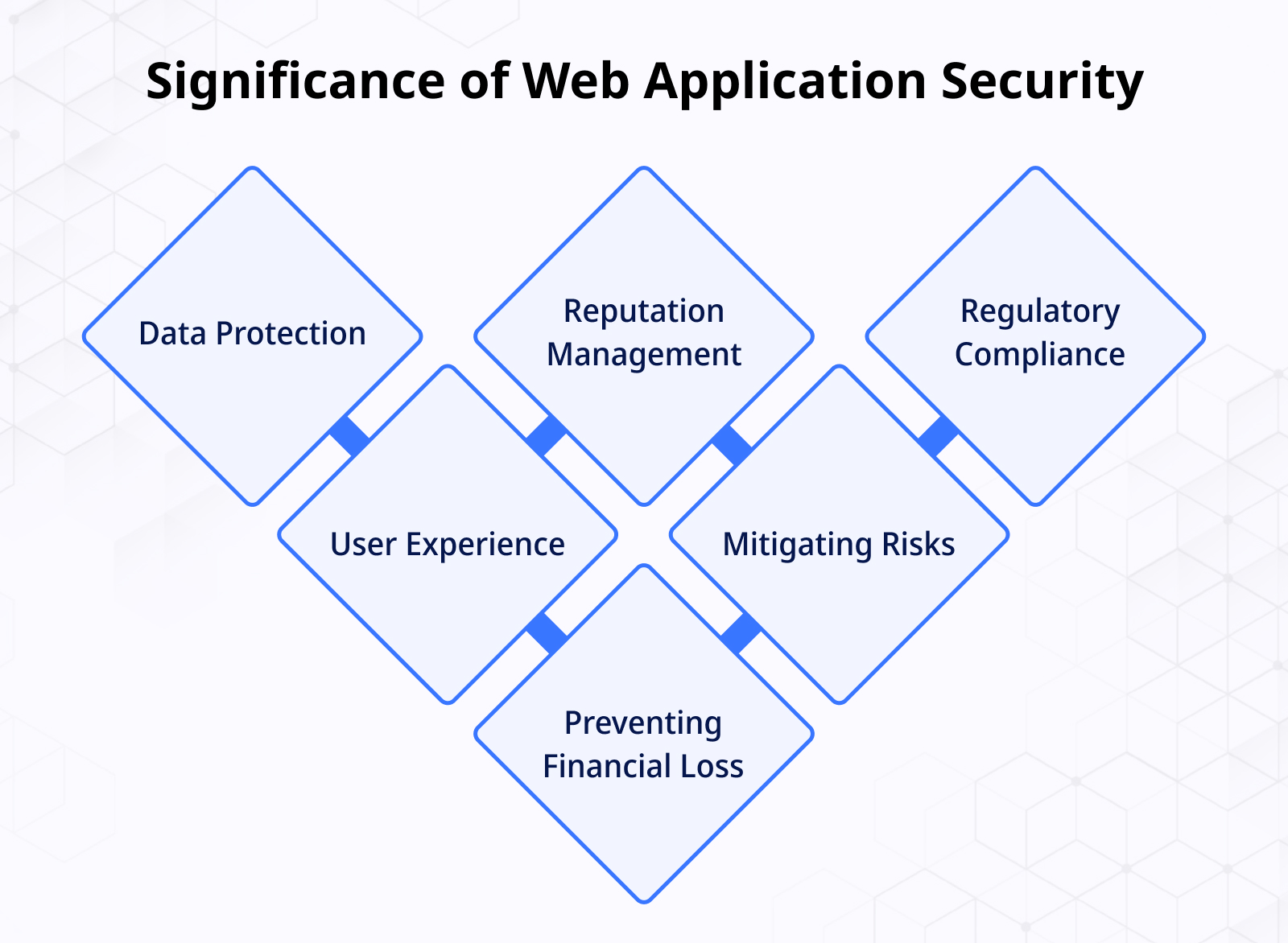
- Data Protection
- Reputation Management
- Regulatory Compliance
- Preventing Financial Loss
- User Experience
- Mitigating Risks
Common Web Application Risks
Web applications face various security risks; understanding them is essential to protect your systems. Here are seven common risks that web application penetration testing can help reveal:
Injection Attacks
Injection attacks can take various forms, with SQL injection being one of the most notorious. In an SQL injection, an attacker typically manipulates user inputs, like login credentials or search queries, to inject malicious SQL commands.
If the application doesn’t properly validate and sanitize user inputs, the attacker can gain unauthorized access to the database, potentially viewing, modifying, or deleting sensitive data.
In addition to SQL injection, other types of injection attacks include OS (Operating System) command injection and XML injection. Preventing these attacks involves:
- Validating and sanitizing all user inputs.
- Using parameterized queries.
- Employing web app security mechanisms like Web Application Firewalls (WAFs).
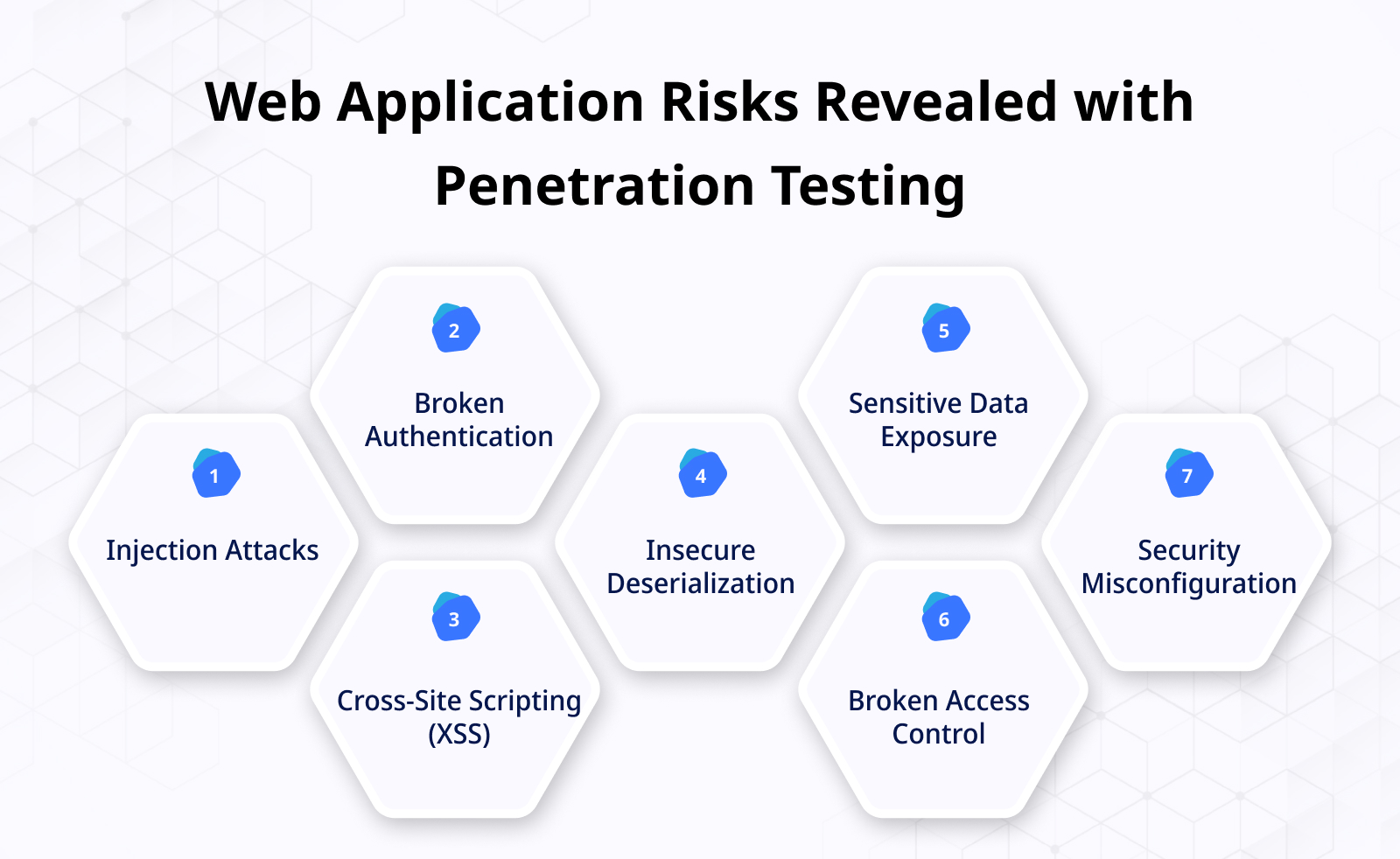
Weak authentication mechanisms are a significant risk. This can result from issues such as poor password management, where users choose weak passwords or reuse passwords across multiple accounts.
Weak session management can lead to session fixation attacks, where an attacker can impersonate a user. Lack of multi-factor authentication (MFA) leaves an application more vulnerable to unauthorized access.
To mitigate these risks, it’s crucial to encourage:
- Strong, unique passwords
- Regularly rotate session tokens
- Implement MFA
Get proactive protection and eliminate vulnerabilities before the hackers do.
Cross-Site Scripting (XSS)
XSS attacks can occur when an application doesn’t properly validate and sanitize user inputs. It enables attackers to inject malicious scripts that are then executed by other users when viewing specific web pages.
The consequences can range from data theft to session hijacking. Stored XSS, where the malicious script is saved on the server, and reflected XSS, where the script is immediately executed, are the two primary categories.
Mitigation penetration testing strategies include:
- Input validation
- Output encoding
- Content Security Policy (CSP) implementation
Insecure Deserialization
Insecure deserialization occurs when an application receives serialized data, but doesn’t adequately validate or sanitize this data. This vulnerability can lead to remote code execution, data tampering, or the creation of a denial-of-service condition.
Attackers manipulate the serialized data to exploit these security gaps.
To protect against insecure deserialization, it’s essential to:
- Validate serialized data
- Restrict deserialization to trusted sources
- Employ security controls like integrity checks
Sensitive Data Exposure
Failing to protect sensitive data adequately can result in breaches. Whether it’s customer financial information, healthcare records, or personal identification, improperly handling sensitive data can have significant consequences.
Mitigate risk through:
- Encryption of sensitive data at rest and in transit.
- Implement access controls to restrict data access to authorized personnel.
- Avoid unnecessary storage of sensitive data.
Broken Access Control
Broken access control happens when an application fails to enforce proper access restrictions. This allows users to access unauthorized application parts or perform unauthorized actions.
For example, if a user can manipulate URLs to access restricted areas, it indicates broken access control.
Preventing this risk requires proper access management, including:
- Setting permissions
- Role-based access controls
- Secure session management
Security Misconfiguration
Security misconfiguration stems from misconfigured settings, permissions, or server configurations.
These missteps can open the door for attackers to exploit vulnerabilities in your application. Common issues include publicly accessible directories, unnecessary open ports, and default credentials.
The best defense is:
- Routine security checks
- Regular security updates
- Robust configurations (such as least privilege principles and proper error handling)
The Role of Web Application Penetration Testing
Penetration testing, often called pen testing or ethical hacking, is pivotal in safeguarding web applications against evolving cyber threats.
It is an established practice where security experts simulate real-world cyberattacks to assess the vulnerabilities and strengths of a web application.
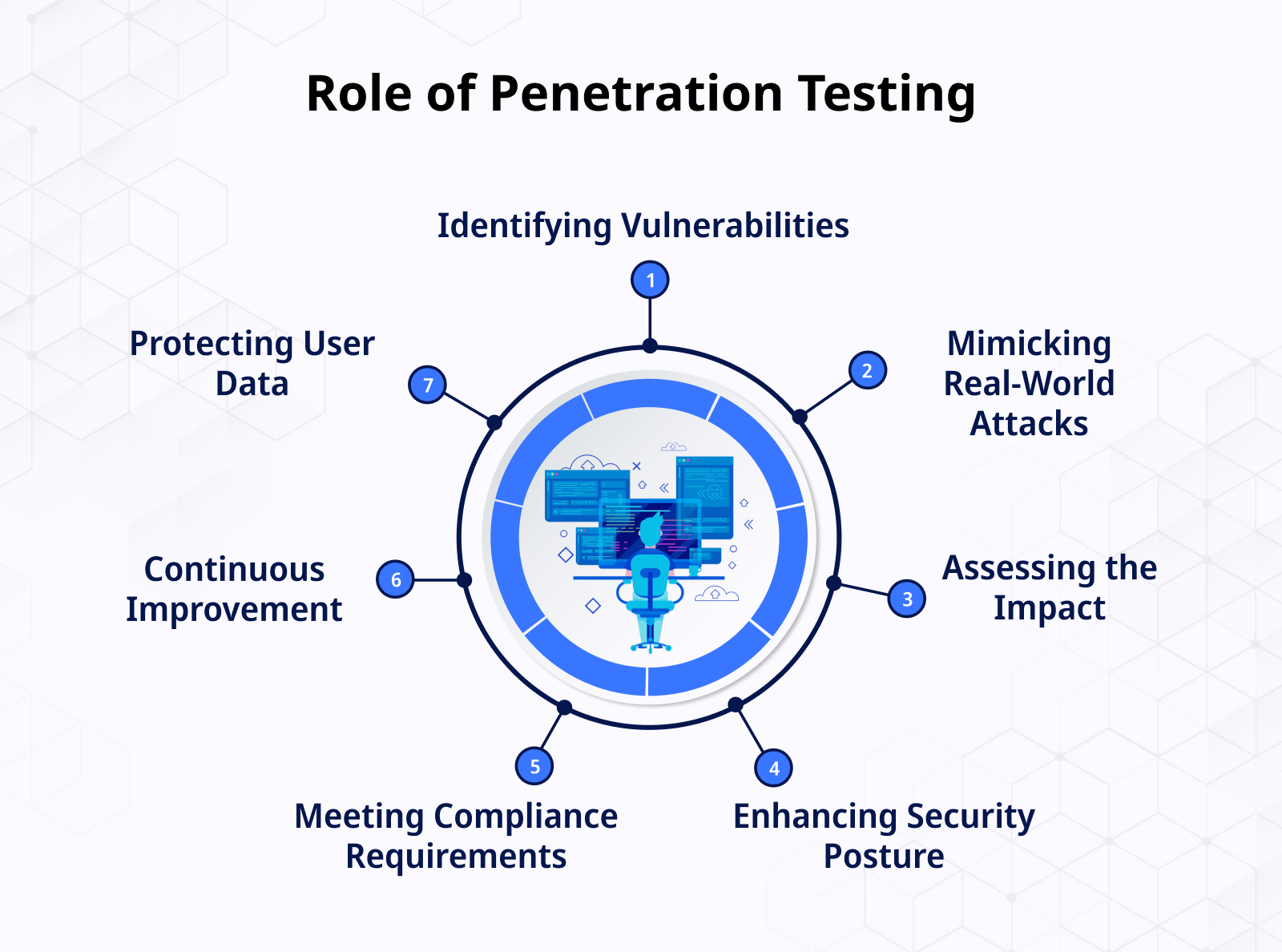
Identifying Vulnerabilities
The primary penetration testing role is to uncover vulnerabilities within a web application.
These vulnerabilities can be anything from misconfigurations to weak passwords and even faulty coding. Businesses can proactively mitigate potential security risks by pinpointing these issues.
Mimicking Real-World Attacks
Penetration tests replicate the techniques employed by malicious hackers to identify and exploit weaknesses.
This simulation provides a realistic assessment of the application’s security posture, enabling organizations to address any vulnerabilities before actual attackers can exploit them.
Assessing the Impact
Penetration testers go beyond merely identifying vulnerabilities; they assess the potential impact of these weaknesses when exploited.
This information is invaluable for businesses to understand the gravity of security flaws and prioritize their remediation efforts.
Enhancing Security Posture
By conducting regular penetration testing, organizations can enhance their security posture.
They can identify areas where security measures are insufficient and implement necessary changes, making it difficult for cybercriminals to compromise their web applications.
Defend against cyber threats with our cutting-edge penetration testing.
Meeting Compliance Requirements
In many industries, businesses must adhere to strict regulatory compliance standards. Penetration testing is often a requirement to ensure compliance, which makes it essential for businesses operating within such sectors.
Continuous Improvement
The role of web application penetration testing extends to fostering a culture of continuous improvement.
After identifying vulnerabilities and weaknesses, organizations can take the necessary steps to fix them and prevent similar issues in the future.
Protecting User Data
Penetration testing safeguards sensitive user data from breaches. In the digital age, the protection of user information is paramount, and penetration testing is a crucial tool in ensuring data privacy.
The Penetration Testing Process
Penetration testing is a structured process that involves several essential steps to identify and mitigate web application risks.
Here’s an overview of the typical web application penetration testing process:
- Planning and Information Gathering: The process begins with thorough planning, defining goals, and understanding the scope of testing. Testers gather information about the target, such as network architecture and application details.
- Scanning and Enumeration: Testers use various web application penetration testing tools to scan the target environment, identifying open ports, services, and system vulnerabilities. Enumeration involves extracting more details about the target.
- Vulnerability Analysis: Testers analyze the gathered information to identify potential vulnerabilities and weaknesses in the application or network. This phase is crucial for understanding the attack surface.
- Exploitation: In this phase, testers attempt to exploit identified vulnerabilities. They simulate real-world attacks to assess security flaws’ severity and potential impact.
- Post-Exploitation: Testers may further assess the compromised system after a successful attack, demonstrating the extent of a potential breach. This step helps in understanding the consequences of a security compromise.
- Reporting and Remediation: Testers prepare a detailed report of their findings, highlighting vulnerabilities and potential risks. Recommendations for remediation and improving web app security are provided to the client.
Guard your web application against evolving threats with our expert testers.
Types of Penetration Testing
Penetration testing comes in different forms, offering a unique security perspective on your web application.
Each testing approach helps you comprehensively understand your web application’s vulnerabilities, ensuring that your security measures are robust from various angles.
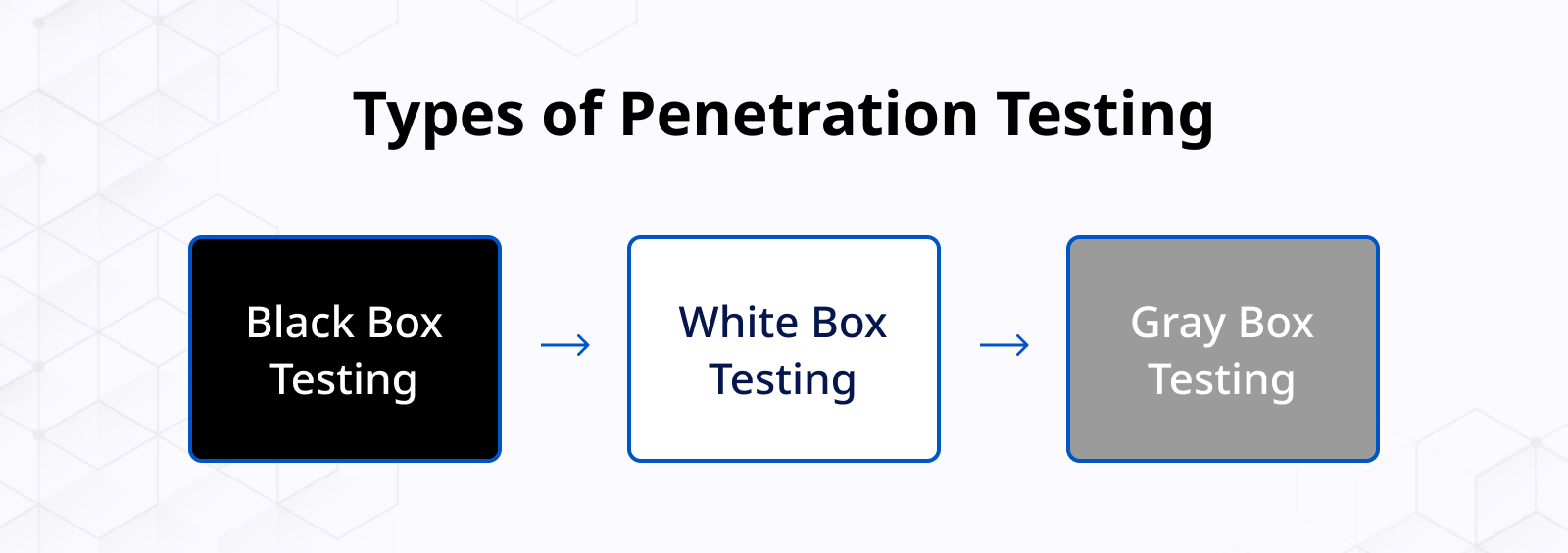
The key types you should be aware of include:
Black Box Testing
Approach: In black box testing, the tester has no prior knowledge of the application or its internal workings. It’s similar to a real-world attacker scenario.
Advantage: This testing method reveals how well your application can stand against external threats, making it particularly useful to understand vulnerabilities that outsiders could exploit.
Use Case: Think of black box testing as a hacker attempting to infiltrate your web application without insider information.
White Box Testing
Approach: White box testing is the complete opposite. Testers can access the application’s source code, architecture, and design.
Advantage: It allows you to identify vulnerabilities that might not be visible from the outside and provides in-depth insights into your application’s security.
Use Case: White box testing simulates an insider threat who has access to your application’s internal workings and assesses the security from within.
Gray Box Testing
Approach: Gray box testing strikes a balance between the two. Testers possess partial knowledge of the application’s internals, emulating a scenario where an attacker has some information about your system.
Advantage: It combines the best of both worlds, effectively identifying vulnerabilities accessible to semi-informed attackers.
Use Case: Gray box testing mirrors a scenario where an attacker possesses some knowledge of your application but not all the details.
Why Businesses are Giving Preference to Penetration Testing?
Businesses increasingly use penetration testing to protect their digital assets and reputation.
Here are five key advantages driving this preference:

Web application pen testing allows businesses to identify vulnerabilities before malicious actors exploit them.
By taking a proactive approach, businesses can address potential risks and fortify their defenses against cyber threats.
Regulatory Compliance
In an era of stringent data protection regulations, penetration testing helps businesses meet compliance requirements.
It demonstrates a commitment to securing sensitive information and minimizes the risk of costly fines resulting from non-compliance.
Enhanced Security Posture
Regular testing provides valuable insights into an organization’s security posture.
By understanding their strengths and weaknesses, businesses can prioritize security investments and continually improve their cyberattack resilience.
Protecting Customer Trust
A data breach can shatter customer trust.
Penetration testing helps maintain the integrity of customer data, safeguarding the trust businesses have worked hard to build.
Demonstrating a strong commitment to security can enhance customer loyalty.
Cost Savings
Investing in penetration testing is cost-effective compared to dealing with the aftermath of a cyberattack.
Businesses can avoid the financial burdens associated with data breaches, legal consequences, and reputational damage by proactively identifying and addressing vulnerabilities.
Our en testing experts reduce risks, ensure compliance, and propel your app toward success.
Choosing the Right Penetration Testing Service
When selecting a penetration testing service, it’s crucial to make an informed choice. Here are some key factors to consider:
- Expertise: Look for a provider with a team of experienced professionals who understand your industry and its unique security challenges.
- Customization: Your business isn’t one-size-fits-all, nor should your testing be. Ensure that the service can tailor its approach to your specific needs.
- Comprehensive Testing: A reliable provider should offer a range of testing methods, from black-box and white-box testing to dynamic and static testing.
- Reporting: The quality of the reporting is essential. You need clear, actionable insights to address vulnerabilities effectively.
- Reputation: Check the provider’s track record. Client reviews and case studies can offer valuable insights.
- Compliance: Ensure the service aligns with industry standards and regulations. This is especially crucial for businesses in highly regulated sectors.
- Cost: While cost is a factor, prioritize the quality of the service over the price. Security is an investment in your business’s future.
Considering these factors, you can make an informed decision when choosing a penetration testing service.
At PixelCrayons, we offer comprehensive web application development services that meet these criteria and more, ensuring that your web app security is in capable hands.
Final Words
Penetration testing emerges as a crucial tool for identifying and mitigating risks that could lead to data breaches, financial losses, and reputation damage.
By revealing the seven web application risks through this testing, businesses can proactively safeguard their systems against potential threats.
Remember, the world of cybersecurity is constantly evolving, as are cybercriminals’ tactics. Regular penetration testing should be a part of your security strategy to stay ahead in this ongoing battle.
It’s not just about fixing vulnerabilities; it’s about staying one step ahead of those who aim to exploit them.
Don’t let the security of your web applications be a guessing game. Embrace web application penetration testing as a proactive measure, ensuring that your digital assets remain protected and your users trust your services.

